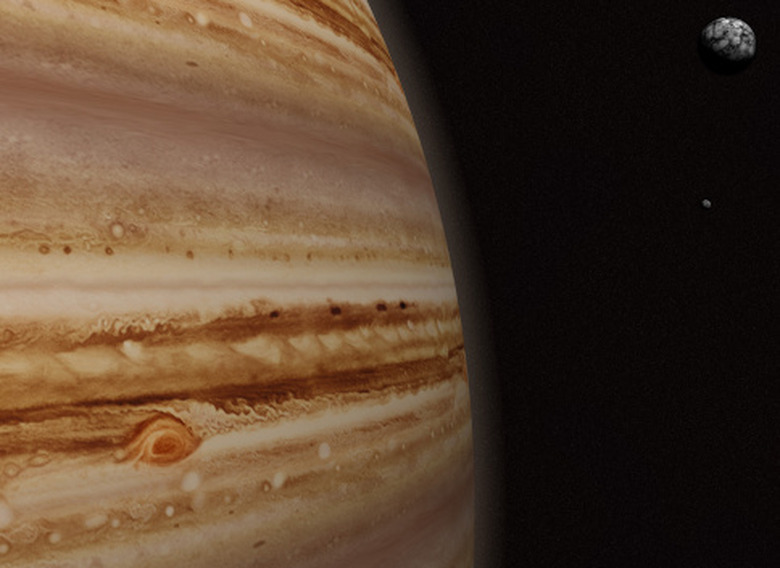Gravitational Factors Of Our Eight Planets
Every body in the universe exerts a gravitational influence on every other body. That includes human bodies, but the force is more important between more massive bodies, such as planets and stars. The gravitational force between two bodies on Earth is negligible, but not the attractive force between a body and the planet itself. It's the glue that prevents everything that isn't tied down from floating off into space.
In general, two bodies exert a gravitational force on each other directly proportional to the product of their masses and inversely proportional to the square of the distance between them:
\(F_g = G {(m_1m_2)\over R^2}\)
where G is the gravitational constant.
When one of the bodies is much larger than the other, as is true for Earth and anything on its surface, its mass predominates. Every object on Earth's surface is attracted to the center of the planet with a force proportional to its mass, giving rise to the adage: "whatever goes up must come down," which is true as long as the object isn't moving fast enough to leave the ground and go into orbit.
Other planets exert the same type of gravitational force on objects on their surface, but the magnitude of this force is different. It depends not only on the planet's mass, but also its density, because the denser a planet is, the more mass there is under your feet pulling you down.
The Gravity of Different Planets
The Gravity of Different Planets
On Earth, falling objects experience an acceleration of 9.8 m/s2 due to Earth's gravitational force, and that is defined as 1 g. The easiest way to discuss the gravitational force on other planets is to express it as a fraction of Earth's g-force.
Jupiter is the largest planet, so you would expect it to have the largest gravitational force, and it does. The reasoning doesn't extend the other way, though. Mercury is the smallest planet, but its surface gravity is about the same as that of the much larger Mars because Mercury is more dense. Similarly, Saturn is much larger than Earth, but it's much less dense, so the gravitational force on Saturn is about the same as it is on Earth.
The gravity you would experience on each of the planets in the solar system if you were standing on the surface or, in the case of the ice giants, floating in the atmosphere, is:
- Mercury: 0.38 g
- Venus: 0.9 g
- Moon: 0.17 g
- Mars: 0.38 g
- Jupiter: 2.53 g
- Saturn: 1.07 g
- Uranus: 0.89 g
- Neptune: 1.14 g
The Gravitational Pull of the Planets
The Gravitational Pull of the Planets
All the planets exert a gravitational pull on Earth, but except for the sun and moon, the magnitude of this pull is basically negligible. This is due to the vast distances between the Earth and the other planets. The gravitational force varies inversely with the square of the distance between bodies but directly only with the first power of mass, so distance is more important.
The moon is small, but it's the closest body to Earth, so its gravitation is strongest. If you express the tidal forces, of all other planets in terms of the moon's force, the results are as follows:
- Moon: 1
- Sun: 0.4
- Venus: 6 × 10-5
- Jupiter: 3 × 10-6
- Mercury: 4 × 10-7
- Saturn: 2 × 10-7
- Mars: 5 × 10-8
- Uranus: 3 × 10-9
- Neptune: 8 × 10-10
Planetary Gravitational Influences Fluctuate
Planetary Gravitational Influences Fluctuate
The planets aren't stationary. Their distance from Earth changes and so, accordingly, does their gravitational influence on our home planet. The magnitude of the force can vary by as much as an order of magnitude. This may be one reason why astrologers throughout the ages have found a correspondence between the positions of the planets and conditions on Earth.
Cite This Article
MLA
Deziel, Chris. "Gravitational Factors Of Our Eight Planets" sciencing.com, https://www.sciencing.com/gravitational-factors-eight-planets-8439815/. 27 December 2020.
APA
Deziel, Chris. (2020, December 27). Gravitational Factors Of Our Eight Planets. sciencing.com. Retrieved from https://www.sciencing.com/gravitational-factors-eight-planets-8439815/
Chicago
Deziel, Chris. Gravitational Factors Of Our Eight Planets last modified March 24, 2022. https://www.sciencing.com/gravitational-factors-eight-planets-8439815/
